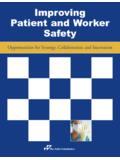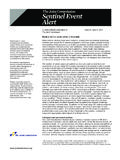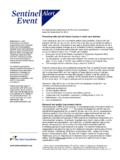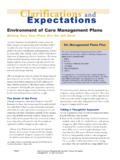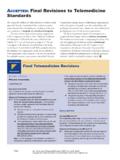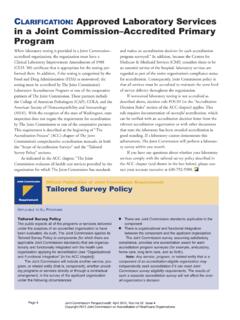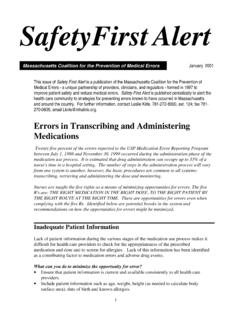Transcription of Sentinel Event Alert - Joint Commission
1 Issue 40: Behaviors that undermine a culture of safety | Joint [9/20/2010 11:54:55 AM] Sentinel Event Alert July 09, 2008 Issue 40, July 9, 2008 Behaviors that undermine a culture of safetyIntimidating and disruptive behaviors can foster medical errors,(1, 2, 3) contribute to poor patient satisfaction and to preventableadverse outcomes,(1, 4, 5) increase the cost of care,(4, 5) and cause qualified clinicians, administrators and managers to seeknew positions in more professional environments. (1, 6) safety and quality of patient care is dependent on teamwork,communication, and a collaborative work environment. To assure quality and to promote a culture of safety , health careorganizations must address the problem of behaviors that threaten the performance of the health care and disruptive behaviors include overt actions such as verbal outbursts and physical threats, as well as passiveactivities such as refusing to perform assigned tasks or quietly exhibiting uncooperative attitudes during routine and disruptive behaviors are often manifested by health care professionals in positions of power.
2 Such behaviorsinclude reluctance or refusal to answer questions, return phone calls or pages; condescending language or voice intonation; andimpatience with questions.(2) Overt and passive behaviors undermine team effectiveness and can compromise the safety ofpatients.(7, 8, 11) All intimidating and disruptive behaviors are unprofessional and should not be and disruptive behaviors in health care organizations are not rare.(1, 2, 7, 8, 9) A survey on intimidation conductedby the Institute for Safe Medication Practices found that 40 percent of clinicians have kept quiet or remained passive duringpatient care events rather than question a known intimidator.(2, 10) While most formal research centers on intimidating anddisruptive behaviors among physicians and nurses, there is evidence that these behaviors occur among other health careprofessionals, such as pharmacists, therapists, and support staff, as well as among administrators.
3 (1,2) Several surveys havefound that most care providers have experienced or witnessed intimidating or disruptive behaviors.(1, 2, 8, 12,13) Thesebehaviors are not limited to one gender and occur during interactions within and across disciplines.(1, 2, 7) Nor are suchbehaviors confined to the small number of individuals who habitually exhibit them.(2) It is likely that these individuals are notinvolved in the large majority of episodes of intimidating or disruptive behaviors. It is important that organizations recognizethat it is the behaviors that threaten patient safety , irrespective of who engages in majority of health care professionals enter their chosen discipline for altruistic reasons and have a strong interest in caringfor and helping other human beings.
4 The preponderance of these individuals carry out their duties in a manner consistent withthis idealism and maintain high levels of professionalism. The presence of intimidating and disruptive behaviors in anorganization, however, erodes professional behavior and creates an unhealthy or even hostile work environment one that isreadily recognized by patients and their families. Health care organizations that ignore these behaviors also expose themselvesto litigation from both employees and patients. Studies link patient complaints about unprofessional, disruptive behaviors andmalpractice risk.(13,14,15) Any behavior which impairs the health care team s ability to function well creates risk, says GeraldHickson, , associate dean for Clinical Affairs and director of the Center for Patient and Professional Advocacy at VanderbiltUniversity Medical Center.
5 If health care organizations encourage patients and families to speak up, their observations andcomplaints, if recorded and fed back to organizational leadership, can serve as part of a surveillance system to identifybehaviors by members of the health care team that create unnecessary risk. Root causes and contributing factorsThere is a history of tolerance and indifference to intimidating and disruptive behaviors in health care.(10) Organizations thatfail to address unprofessional behavior through formal systems are indirectly promoting it. (9, 11) Intimidating and disruptivebehavior stems from both individual and systemic factors.(4) The inherent stresses of dealing with high stakes, high emotionsituations can contribute to occasional intimidating or disruptive behavior, particularly in the presence of factors such as care providers who exhibit characteristics such as self-centeredness, immaturity, or defensiveness can be more proneto unprofessional behavior.
6 (8, 11) They can lack interpersonal, coping or conflict management skills. Systemic factors stem from the unique health care cultural environment, which is marked by pressures that include increasedproductivity demands, cost containment requirements, embedded hierarchies, and fear of or stress from litigation. Thesepressures can be further exacerbated by changes to or differences in the authority, autonomy, empowerment, and roles orvalues of professionals on the health care team, (5,7, 16) as well as by the continual flux of daily changes in shifts, rotations,and interdepartmental support staff. This dynamic creates challenges for inter-professional communication and for thedevelopment of trust among team behaviors often go unreported, and therefore unaddressed, for a number of reasons.
7 Fear of retaliation and thestigma associated with blowing the whistle on a colleague, as well as a general reluctance to confront an intimidator allcontribute to underreporting of intimidating and/or disruptive behavior.(2, 9, 12,16) Additionally, staff within institutions oftenperceive that powerful, revenue-generating physicians are let off the hook for inappropriate behavior due to the perceivedconsequences of confronting them.(8, 10,12,17) The American College of Physician Executives (ACPE) conducted a physicianbehavior survey and found that percent of the respondents agreed that "physicians in my organization who generate highamounts of revenue are treated more leniently when it comes to behavior problems than those who bring in less revenue.
8 "(17)Existing Joint Commission requirementsEffective January 1, 2009 for all accreditation programs, The Joint Commission has a new Leadership standard ( )*that addresses disruptive and inappropriate behaviors in two of its elements of performance:Issue 40: Behaviors that undermine a culture of safety | Joint [9/20/2010 11:54:55 AM]EP 4: The hospital/organization has a code of conduct that defines acceptable and disruptive and 5: Leaders create and implement a process for managing disruptive and inappropriate addition, standards in the Medical Staff chapter have been organized to follow six core competencies (see the introduction ) to be addressed in the credentialing process, including interpersonal skills and Joint Commission suggested actions1.
9 Educate all team members both physicians and non-physician staff on appropriate professional behavior defined by theorganization s code of conduct. The code and education should emphasize respect. Include training in basic businessetiquette (particularly phone skills) and people skills.(10, 18,19)2. Hold all team members accountable for modeling desirable behaviors, and enforce the code consistently and equitablyamong all staff regardless of seniority or clinical discipline in a positive fashion through reinforcement as well aspunishment.(2, 4, 9, 10,11)3. Develop and implement policies and procedures/processes appropriate for the organization that address: Zero tolerance for intimidating and/or disruptive behaviors, especially the most egregious instances of disruptivebehavior such as assault and other criminal acts.
10 Incorporate the zero tolerance policy into medical staff bylaws andemployment agreements as well as administrative staff policies regarding intimidating and/or disruptive behaviors of physicians within a health care organizationshould be complementary and supportive of the policies that are present in the organization for non-physician fear of intimidation or retribution and protecting those who report or cooperate in the investigation ofintimidating, disruptive and other unprofessional behavior.(10,18) Non-retaliation clauses should be included in allpolicy statements that address disruptive to patients and/or their families who are involved in or witness intimidating and/or disruptive response should include hearing and empathizing with their concerns, thanking them for sharing those concerns,and apologizing.
